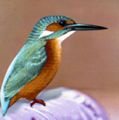Kingfisher
Kingfisher (machhranga) a group of compact-bodied birds usually with short tails, large heads and long, heavy, pointed bills, belonging to the families Alcedinidae, Halcyonidae and Cerylidae of the order Coraciiformes. About 94 species of kingfishers occur worldwide; the centre of abundance is Southeast Asia and New Guinea, but tropical Africa also has strong representation. In Bangladesh there are 12 species, two of which are threatened: one is endangered and the other one is vulnerable; three could not be evaluated due to paucity of data; seven do not have any immediate threats.
-
White breasted Kingfisher
-
Brown-winged Kingfisher
-
Common Kingfisher
-
Collared Kingfisher
-
Stork-billed Kingfisher
-
Pied Kingfisher
The most visible distinguishing features of the kingfishers are their bill and feet. The legs are very short, and the toes are syndactyl, the third and fourth being joined along most of their length, and the second and third joined basally; in some species the second toe is much reduced or absent altogether. A 'typical' kingfisher bill is proportionately large, robust, generally long and straight, with a sharply pointed or slightly hooked tip. Kingfishers vary in size, with a length of 10 cm to more than 40 cm and weight of 10 gm to 400 gm. Their plumage is commonly of bright colours, often with a metallic brilliance, in blues, greens, purple and reddish or brown tones, which are frequently offset with white patches or dark markings. The wings tend to be short and rounded, while the tail varies from extremely short to very long.
Table Kingfishers of Bangladesh.
| English name | Scientific name | Local name | Distribution |
| Common Kingfisher | Alcedo atthis | Choto machhranga | Wide |
| Blyth’s Kingfisher | Alcedo hercules | --- | Mixed Evergreen Forest |
| Blue-eared Kingfisher | Alcedo meninting | --- | Southeast, Central and South in wooded wetlands |
| Brown-winged Kingfisher | Halcyon amauroptera [Pelargopsis amauroptera] | Machhranga | SundarbansMangrove Forest |
| Stork-billed Kingfisher | Halcyon capensis [Pelargopsis capensis] | Megh-hao | Wide |
| Ruddy Kingfisher | Halcyon coromandra | Lal machhranga | Sundarbans Mangrove Forest |
| Black-capped Kingfisher | Halcyon pileata | --- | Coasts including St Martin’s Island |
| White-throated Kingfisher [White-breasted Kingfisher] | Halcyon smyrnensis | Machhranga | Wide |
| Collared Kingfisher [White-collared Kingfisher] | Todiramphus chloris [Halcyon chloris] | --- | Coasts including St Martin’s Island |
| Pied Kingfisher [Lesser Pied Kingfisher] | Ceryle rudis | Pakra machhranga | Wide |
| Oriental Dwarf Kingfisher [Threetoed Kingfisher] | Ceyx erithacus | Buno machhranga | Forests |
| Crested Kingfisher | Megaceryle lugubris [Ceryle lugubris] | --- | --- |
NB: Previous names are given in square brackets
Kingfishers inhabit a wide variety of aquatic and wooded habitats. The normal breeding unit is a monogamous pair, which may nest solitarily or in loose colonies. Nests are in natural hollows in trees or in burrows excavated by the birds in earth-banks, termite mounds, or rotten-tree stumps. Both sexes excavate the burrow by prizing loose the soil or rotten wood with the bill, and then by using their feet to kick out the dislodged material. Kingfishers perch on dead branches, watching for small fishes, frogs and large aquatic insects. They dive headlong into the water to capture prey, often submerging completely; the prey are struck against the perch several times, tossed into the air and swallowed headfirst. [Md Anwarul Islam]






